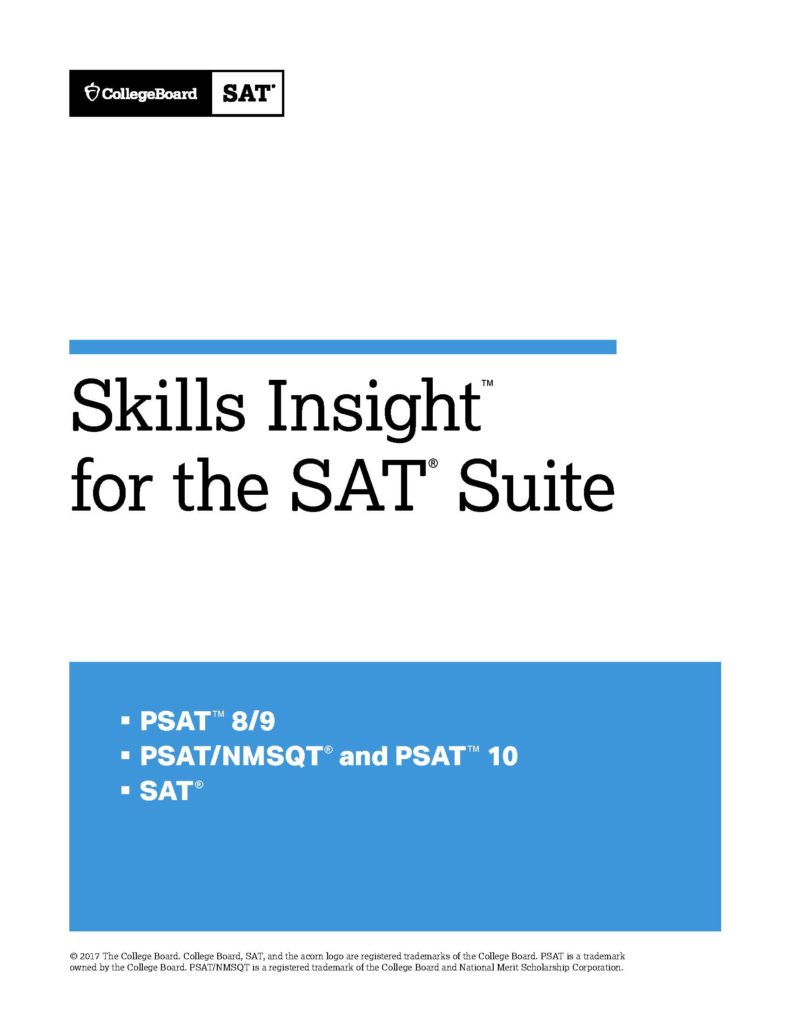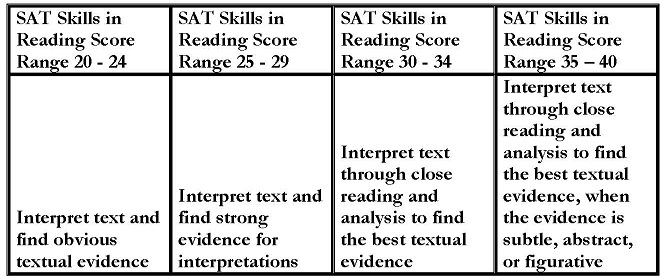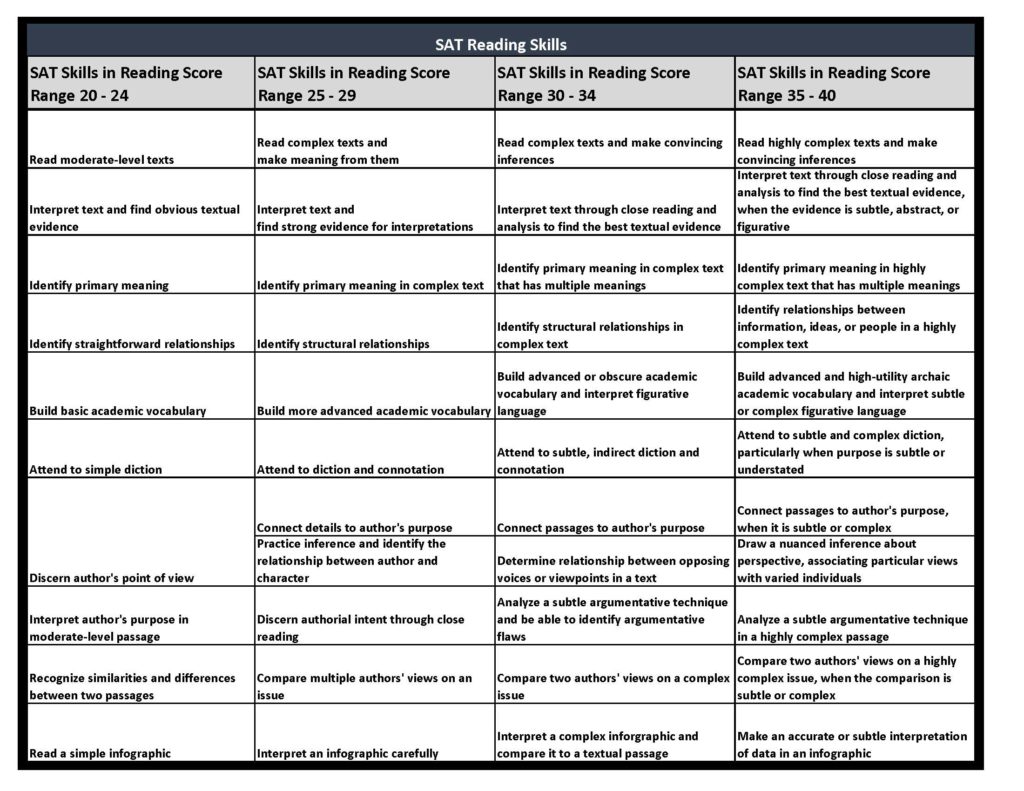
Concentrating and Practicalizing SAT Skills Insight
The SAT suite of assessments have emerged as probably the leading tool for measurement of secondary school learning and student achievement. The SAT, of course, is one of the two national college admissions exams, which makes it an inherently important test for high schools committed to preparing all of their students for college. The PSAT 9th and 10th grade assessments help keep students on track for the continued development of the skills that the exam, and its College Board designers, believe are essential to be college-ready. And for a growing number of states – twelve right now, including Illinois – the SAT suite is used for required assessment of all public high school students, in many instances as a replacement for the Common Core assessments PARCC or SmarterBalanced, with the reasoning that the SAT is CCS-aligned and thus administering it covers both college-entrance and CCS assessment in one test.
Argument-Centered Education works with each of its partner high schools to make intentional and direct connections between academic argumentation and skills that are the focus of the SAT suite of assessments. Academic argumentation is already highly aligned with the Common Core so it is a short, pathed route to aligning and calibrating argument-based instruction with the steady, continuous instructional work to prepare our partner school students for success on the SAT suite. And, in fact, ACE has been recognized as one of the leading providers of curriculum and coaching for instruction that is SAT-aligned. But, though the work is highly apposite, this kind of alignment, to actually achieve the desired results, takes intentionality and planning, on the school’s part (by both administrators and teachers) and on our part in our argumentalizing and implementation support work.
One significant assist in our process of aligning and calibrating argument-centered instruction with SAT academic skills development has been the report published by the College Board called Skills Insight for the SAT Suite.

[Post the Skills Insight document here]
The report describes specific levels of academic skill and performance at four or five score bands across the SAT Suite, dividing these descriptions by exam categories: evidence-based reading and writing, writing and language, math, and the rhetorical analysis essay. Teachers can look at their students’ scores, identify the score bands of their students, and build into their curriculum and instruction teaching, practice, and assessment on the skills that will enable students to move into the next score band, or even the one above that (if applicable).
Early in our work with this document, however, teachers and we ourselves were finding it somewhat cumbersome and verbose. So we concentrated the academic skills descriptors by exam category (reading, writing/language, and essay) and put them on a grid, to help teachers get to the essence of the skill more easily, and to see how that skill develops and becomes more advanced as a student rises in their SAT score band. To give an example, in the SAT reading skills, students are asked to identify textual evidence to support an interpretation or meaning-making that they perform on a text. Here is how the performance of that skill is described by our concentration of the SAT Skills Insight.


One thing (among many) to notice about the ACE-concentration is that the Reading score band descriptors are more concise than the Writing/Language ones are. This is primarily because the Writing/Language descriptors in the SAT skill bands are more mechanical and more precise — students either have particular technical skills in writing sentences and paragraphs, and using punctuation and diction, or they don’t. More so than reading skills like “interpret,” “infer,” “connect,” “synthesize.” There are writing skills that are similarly higher-order — skills such as “support,” “analyze,” “logically structure” — and they are included too in the Writing/Language page of the document.
Our concentration of the SAT Skills Insight resource, and laying out all of the literacy skills it identifies as being assessed by the exam (we didn’t leave any out, our concentrated resource captures and condenses the entirety) is itself a practicalization of the resource. In other words, it is far easier now for our partner teachers to review SAT Suite score bands for their students and look up the skills that they should be emphasizing and exercising in their instruction and on their own assessments. We have also been using this concentrated insight document to practicalize the alignment of argument-centered instruction with instruction that is informed by an interest in improving student preparation and readiness for success on the exam.
In many instances, this alignment suggests itself, as is the case with the reading skill that requires students to identify the best textual evidence, through close reading and analysis, of their textual interpretation. Most argument-centered instructional resources involve this skill in an important way, through the concentrated insight document can suggest different levels of difficulty and varied aspects of the skill. Much of the essay skills page of this resource falls into this category of alignment that suggests itself, with the above caveats and qualifications.
Other skills identified by the insight document have connections to argument-centered instruction that can readily be made with proper planning and intention. The writing and language skill of using transitional words or phrases to suggest logical relationships between textual sections, for instance, can be brought into any argument writing assessment through the use of the ACE transitions set. Similarly, the skill that entails ordering and organizing support for claims can be added to an ACE rubric on a specific assessment, after being taught to students and exercised in lead-up to the final work product.
These are only a few of the many examples of the ways that argumentation and the SAT can, should, and are coalescing in our partner schools, to the benefit of instructional rigor, college-readiness, and, yes, SAT performance as well.
When we talk about infusing our instruction — especially but not exclusively our argument-centered instruction — with SAT preparing and aligned skills, we should be going to documents like the ACE-concentrated Skill Insight resource and building these skills into our activities, projects, and assessments.

